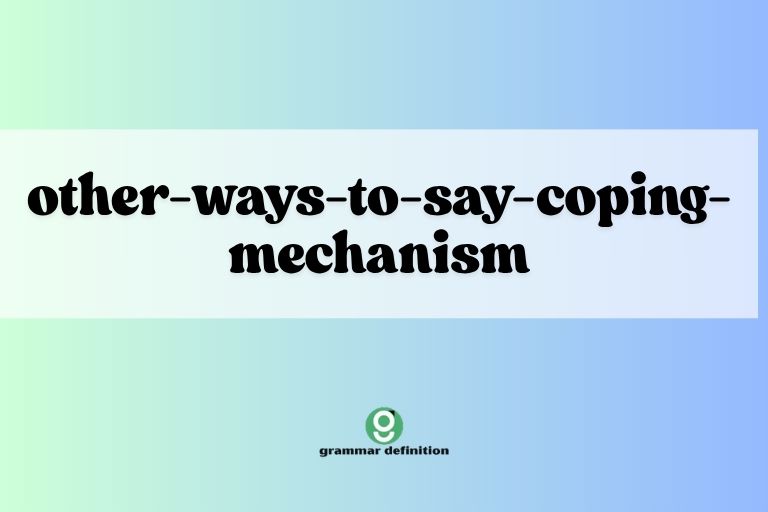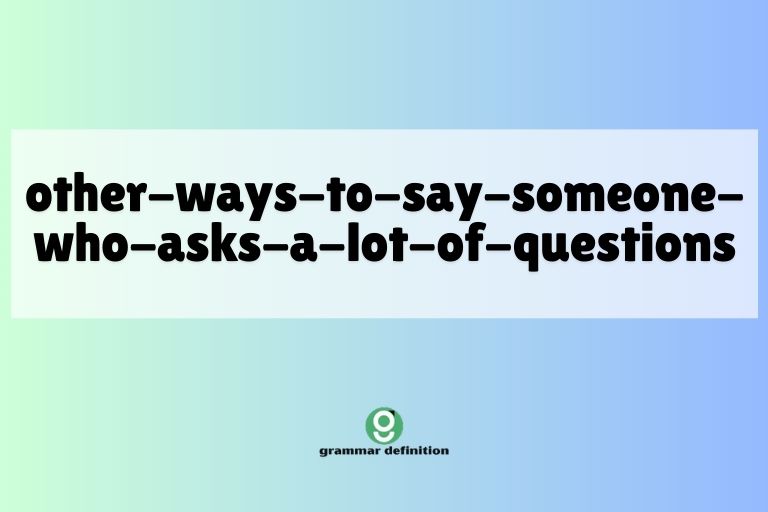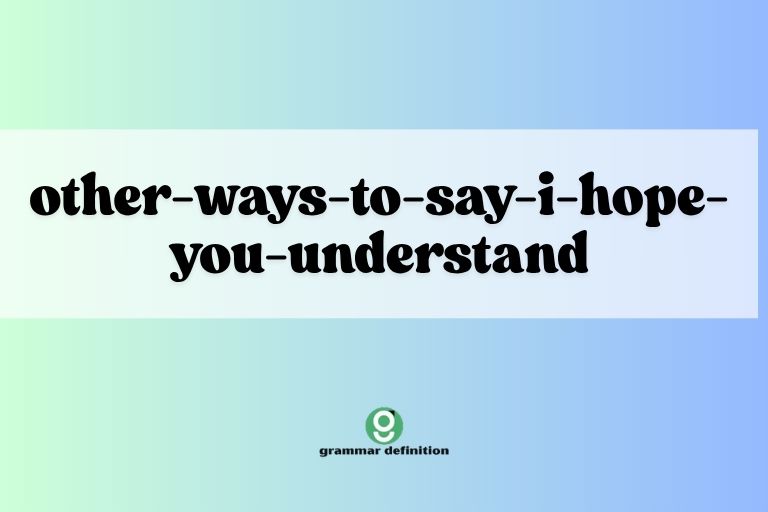Alternative Ways to Express “Coping Mechanism”: A Comprehensive Guide

Understanding and articulating how individuals manage stress and difficult situations is a crucial aspect of effective communication, both personally and professionally. The term “coping mechanism” is widely used, but a diverse vocabulary allows for more nuanced and precise expression.
This article delves into various alternatives to “coping mechanism,” exploring their meanings, contexts, and appropriate usage. Whether you’re a student, writer, therapist, or simply someone looking to enhance their communication skills, this guide will equip you with a richer understanding and a wider range of options for discussing how people navigate life’s challenges.
This article will benefit anyone looking to expand their vocabulary related to mental health, psychology, or general well-being. By exploring different ways to express the idea of a “coping mechanism,” you’ll be able to communicate with greater clarity and empathy, fostering deeper understanding in your interactions.
Table of Contents
- Introduction
- Defining “Coping Mechanism”
- Structural Breakdown of Alternative Phrases
- Types and Categories of Coping Strategies
- Examples of Alternative Expressions
- Usage Rules and Considerations
- Common Mistakes to Avoid
- Practice Exercises
- Advanced Topics
- Frequently Asked Questions
- Conclusion
Defining “Coping Mechanism”
A coping mechanism is a psychological strategy that individuals use to deal with stress, trauma, or other challenging emotions and situations. These mechanisms can be conscious or unconscious and aim to reduce negative feelings, maintain emotional stability, and protect mental well-being. Coping mechanisms can be classified as either adaptive (healthy and helpful) or maladaptive (unhealthy and potentially harmful).
In essence, a coping mechanism serves as a buffer against adversity, allowing individuals to navigate difficult circumstances without being overwhelmed. It’s important to recognize that coping mechanisms are not inherently good or bad; their effectiveness depends on the context, the individual, and the long-term consequences of their use.
Structural Breakdown of Alternative Phrases
When seeking alternatives to “coping mechanism,” it’s helpful to understand the structural components of such phrases. These alternatives often consist of a noun describing the action or process (e.g., “strategy,” “technique,” “method”) combined with a prepositional phrase indicating the purpose or context (e.g., “for dealing with stress,” “to manage anxiety”).
The structure typically follows this pattern: [Noun] + [Preposition] + [Description of the Challenge]. For example:
- Strategy for managing stress
- Technique to alleviate anxiety
- Method of dealing with grief
- Approach to handling conflict
Understanding this structure allows for greater flexibility in creating alternative phrases that accurately reflect the specific coping process being described. It also provides a framework for analyzing and understanding the nuances of different coping strategies.
Types and Categories of Coping Strategies
Coping strategies can be broadly categorized into two main types: adaptive and maladaptive. Understanding these categories is crucial for evaluating the effectiveness and long-term impact of different coping mechanisms.
Adaptive Coping Strategies
Adaptive coping strategies are those that promote well-being and help individuals effectively manage stress and difficult emotions. These strategies are generally considered healthy and constructive, leading to positive outcomes in the long run. Examples of adaptive coping strategies include problem-solving, seeking social support, practicing mindfulness, and engaging in physical exercise.
These strategies often involve actively addressing the source of stress or modifying one’s thoughts and feelings in a healthy way. They contribute to resilience and emotional growth, enabling individuals to navigate challenges with greater confidence and effectiveness.
Maladaptive Coping Strategies
Maladaptive coping strategies, on the other hand, are those that may provide temporary relief from stress but ultimately have negative consequences. These strategies are often unhealthy and destructive, leading to further problems in the long run. Examples of maladaptive coping strategies include substance abuse, avoidance, self-harm, and aggression.
While these strategies may offer immediate escape from uncomfortable emotions, they do not address the underlying issues and can exacerbate problems over time. They can also lead to addiction, relationship difficulties, and mental health issues.
Examples of Alternative Expressions
Here are several alternative ways to express “coping mechanism,” categorized by the noun used. Each category provides a range of examples to illustrate different contexts and nuances.
Strategies
The term “strategy” implies a planned and deliberate approach to managing stress or difficult situations. It suggests a conscious effort to implement specific actions or techniques.
The following table provides examples using “strategy” as an alternative to “coping mechanism.”
| Example | Context |
|---|---|
| Her primary strategy for dealing with anxiety is deep breathing exercises. | Managing anxiety |
| Developing effective strategies to manage workplace stress is crucial for employee well-being. | Workplace stress |
| One strategy for overcoming procrastination is to break tasks into smaller, more manageable steps. | Procrastination |
| His strategy for coping with grief involved seeking support from friends and family. | Grief |
| Mindfulness meditation is a powerful strategy for reducing stress and improving mental clarity. | Stress reduction |
| The athlete’s strategy for maintaining focus during competition involves visualization techniques. | Maintaining focus |
| A common strategy for managing conflict is active listening and open communication. | Conflict management |
| Her strategy for dealing with criticism is to focus on the constructive aspects and learn from her mistakes. | Dealing with criticism |
| Implementing healthy lifestyle strategies, such as regular exercise and a balanced diet, can improve overall well-being. | Improving well-being |
| One strategy for building resilience is to cultivate a strong social support network. | Building resilience |
| Cognitive restructuring is a strategy used in therapy to challenge and change negative thought patterns. | Cognitive restructuring |
| The company implemented a new strategy for improving employee morale, including team-building activities and flexible work arrangements. | Improving employee morale |
| Her strategy for overcoming her fear of public speaking involved practicing in front of small groups and gradually increasing the audience size. | Overcoming fear |
| Developing effective time management strategies is essential for achieving academic success. | Time management |
| One strategy for improving sleep quality is to establish a consistent bedtime routine and create a relaxing sleep environment. | Improving sleep quality |
| The student’s strategy for tackling difficult assignments was to break them down into smaller, more manageable tasks. | Tackling assignments |
| A successful strategy for weight loss involves a combination of healthy eating and regular exercise. | Weight loss |
| Her strategy for maintaining a positive attitude is to focus on gratitude and appreciate the good things in her life. | Maintaining a positive attitude |
| The therapist recommended a strategy of journaling to help her process her emotions. | Emotional processing |
| His strategy for staying motivated was to set achievable goals and reward himself for his progress. | Staying motivated |
| The organization’s strategy for fundraising involved a combination of online campaigns and community events. | Fundraising |
| Her strategy for learning a new language was to immerse herself in the culture and practice speaking with native speakers. | Learning a new language |
| A key strategy for successful negotiation is to understand the other party’s interests and find mutually beneficial solutions. | Negotiation |
| His strategy for dealing with difficult customers was to remain calm, listen empathetically, and offer solutions. | Customer service |
Tactics
The term “tactic” refers to a specific action or maneuver used to achieve a particular goal. It often implies a more immediate or short-term approach compared to a strategy.
The following table provides examples using “tactic” as an alternative to “coping mechanism.”
| Example | Context |
|---|---|
| One tactic for calming down during a panic attack is to focus on your breath. | Panic attacks |
| Using humor as a tactic to diffuse tense situations can be effective, but it’s important to be sensitive. | Tense situations |
| His tactic for avoiding conflict was to withdraw from the situation. | Avoiding conflict |
| A common tactic for managing cravings is to distract yourself with another activity. | Managing cravings |
| She used the tactic of positive self-talk to boost her confidence before the presentation. | Boosting confidence |
| The negotiator employed a tactic of silence to encourage the other party to make a concession. | Negotiation |
| His tactic for staying awake during long drives was to listen to upbeat music and take frequent breaks. | Staying awake |
| A tactic for improving memory is to use mnemonic devices. | Improving memory |
| She used the tactic of visualization to prepare for her athletic competition. | Athletic competition |
| His tactic for dealing with insomnia was to practice progressive muscle relaxation. | Insomnia |
| The debater’s tactic was to use logical fallacies to undermine his opponent’s arguments. | Debate |
| A tactic for resisting peer pressure is to have a pre-planned exit strategy. | Peer pressure |
| She used the tactic of reframing to change her perspective on the situation. | Reframing |
| His tactic for managing his anger was to count to ten before reacting. | Anger management |
| A tactic for improving communication skills is to practice active listening. | Communication skills |
| The salesperson’s tactic was to create a sense of urgency to close the deal. | Sales |
| She used the tactic of setting boundaries to protect her time and energy. | Setting boundaries |
| His tactic for dealing with negative feedback was to ask clarifying questions and seek specific examples. | Negative feedback |
| A tactic for improving problem-solving skills is to break the problem down into smaller parts. | Problem-solving |
| She used the tactic of mindfulness to stay present in the moment and reduce her anxiety. | Mindfulness |
| The politician’s tactic was to appeal to the emotions of the voters. | Politics |
| His tactic for managing his fear of heights was to gradually expose himself to higher altitudes. | Fear of heights |
| A tactic for improving teamwork is to establish clear roles and responsibilities. | Teamwork |
| She used the tactic of visualization to mentally rehearse her performance. | Performance |
Techniques
The term “technique” refers to a specific method or skill used to achieve a desired outcome. It often implies a more structured and systematic approach compared to a tactic.
The following table provides examples using “technique” as an alternative to “coping mechanism.”
| Example | Context |
|---|---|
| Progressive muscle relaxation is a common technique for reducing stress and promoting relaxation. | Stress reduction |
| Cognitive behavioral therapy (CBT) uses various techniques to challenge and change negative thought patterns. | Cognitive behavioral therapy |
| His technique for improving his public speaking skills involved practicing in front of a mirror. | Public speaking |
| A common technique for managing pain is to use distraction and imagery. | Pain management |
| She used the technique of journaling to process her emotions and gain insights into her thoughts and feelings. | Emotional processing |
| The artist’s technique involved layering colors to create depth and texture in his paintings. | Art |
| His technique for memorizing information was to use spaced repetition. | Memorization |
| A technique for improving sleep is to practice good sleep hygiene. | Sleep improvement |
| She used the technique of mindfulness meditation to stay present in the moment. | Mindfulness |
| His technique for dealing with anxiety was to use grounding exercises. | Anxiety management |
| The chef’s technique for cooking the perfect steak involved searing it at high heat and then finishing it in the oven. | Cooking |
| A technique for improving problem-solving skills is to use the scientific method. | Problem-solving |
| She used the technique of assertive communication to express her needs and boundaries. | Assertive communication |
| His technique for managing his anger was to take a time-out and engage in a calming activity. | Anger management |
| A technique for improving focus is to eliminate distractions and create a dedicated workspace. | Focus improvement |
| The musician’s technique involved using complex harmonies and rhythms to create a unique sound. | Music |
| She used the technique of positive self-talk to challenge negative thoughts and boost her confidence. | Positive self-talk |
| His technique for managing his stress was to engage in regular physical exercise. | Stress management |
| A technique for improving memory is to use visualization and association. | Memory improvement |
| She used the technique of deep breathing to calm her nerves before the presentation. | Nerve calming |
| The software developer’s technique involved using agile methodologies to manage the project. | Software development |
| His technique for learning a new skill was to break it down into smaller, more manageable steps. | Skill acquisition |
| A technique for improving teamwork is to foster open communication and collaboration. | Teamwork improvement |
| She used the technique of reframing to change her perspective on the situation and find a more positive outlook. | Reframing |
Methods
The term “method” refers to a systematic or established way of doing something. It often implies a more formal or standardized approach compared to a technique.
The following table provides examples using “method” as an alternative to “coping mechanism.”
| Example | Context |
|---|---|
| His method of dealing with stress involved regular exercise and a healthy diet. | Stress management |
| The scientific method is a systematic approach to conducting research and gathering evidence. | Scientific research |
| Her method for improving her writing skills involved practicing regularly and seeking feedback. | Writing skills |
| A common method of conflict resolution is mediation. | Conflict resolution |
| He used the method of cognitive restructuring to challenge and change his negative thought patterns. | Cognitive restructuring |
| The teacher’s method for teaching math involved using hands-on activities and real-world examples. | Teaching |
| His method for memorizing information was to use flashcards and spaced repetition. | Memorization |
| A method for improving sleep quality is to establish a consistent bedtime routine. | Sleep quality |
| She used the method of mindfulness meditation to stay present in the moment and reduce her anxiety. | Mindfulness |
| His method for dealing with his fear of public speaking was to practice in front of small groups. | Public speaking |
| The company’s method for managing projects involved using agile methodologies and frequent communication. | Project management |
| A method for improving problem-solving skills is to break the problem down into smaller parts. | Problem-solving |
| She used the method of assertive communication to express her needs and boundaries effectively. | Assertive communication |
| His method for managing his anger was to take a time-out and engage in a calming activity. | Anger management |
| A method for improving focus is to eliminate distractions and create a dedicated workspace. | Focus improvement |
| The artist’s method involved using a variety of techniques to create texture and depth in her paintings. | Art |
| She used the method of positive self-talk to challenge negative thoughts and boost her confidence. | Positive self-talk |
| His method for managing his stress was to engage in regular physical exercise and spend time in nature. | Stress management |
| A method for improving memory is to use visualization and association techniques. | Memory improvement |
| She used the method of deep breathing to calm her nerves before the important presentation. | Nerve calming |
| The chef’s method for preparing the dish involved using fresh, high-quality ingredients and precise cooking techniques. | Cooking |
| His method for learning a new language was to immerse himself in the culture and practice speaking with native speakers. | Language learning |
| A method for improving teamwork is to foster open communication, collaboration, and mutual respect. | Teamwork improvement |
| She used the method of reframing to change her perspective on the situation and find a more positive outlook. | Reframing |
Approaches
The term “approach” refers to a way of dealing with a situation or problem. It often implies a more general or philosophical perspective compared to a method or technique.
The following table provides examples using “approach” as an alternative to “coping mechanism.”
| Example | Context |
|---|---|
| Her approach to dealing with conflict is to listen empathetically and seek common ground. | Conflict resolution |
| A mindful approach to life involves paying attention to the present moment without judgment. | Mindfulness |
| His approach to problem-solving is to break the problem down into smaller, more manageable parts. | Problem-solving |
| A holistic approach to health considers the interconnectedness of mind, body, and spirit. | Holistic health |
| She takes a proactive approach to managing her stress by engaging in regular exercise and relaxation techniques. | Stress management |
| The company’s approach to customer service is to prioritize customer satisfaction and build long-term relationships. | Customer service |
| His approach to learning new skills is to embrace challenges and view mistakes as opportunities for growth. | Skill acquisition |
| A collaborative approach to teamwork involves fostering open communication and mutual respect. | Teamwork |
| She takes a compassionate approach to parenting, focusing on understanding and supporting her children’s needs. | Parenting |
| His approach to managing his finances is to create a budget and track his expenses carefully. | Financial management |
| The school’s approach to education is to foster critical thinking, creativity, and lifelong learning. | Education |
| A positive approach to life involves focusing on gratitude and appreciating the good things in your life. | Positive attitude |
| She takes a balanced approach to her work and personal life, ensuring that she has time for both. | Work-life balance |
| His approach to managing his time is to prioritize tasks and avoid procrastination. | Time management |
| A sustainable approach to living involves making choices that minimize environmental impact. | Sustainability |
| The artist’s approach involved experimenting with different mediums and techniques to create unique and innovative works. | Art |
| She takes a mindful approach to eating, paying attention to her body’s hunger and fullness cues. | Mindful eating |
| His approach to managing his anxiety is to use relaxation techniques and seek support from friends and family. | Anxiety management |
| A creative approach to problem-solving involves thinking outside the box and exploring unconventional solutions. | Creative problem-solving |
| She takes a proactive approach to her health by getting regular checkups and following a healthy lifestyle. | Proactive health |
| The leader’s approach involved empowering his team members and fostering a culture of collaboration and innovation. | Leadership |
| His approach to learning a new language is to immerse himself in the culture and practice speaking with native speakers. | Language learning |
| A strategic approach to business involves setting clear goals, analyzing the market, and developing a competitive advantage. | Business strategy |
| She takes a compassionate approach to her relationships, focusing on empathy, understanding, and forgiveness. | Relationships |
Usage Rules and Considerations
When choosing an alternative to “coping mechanism,” consider the specific context and the nuance you want to convey. “Strategy” implies a planned approach, “tactic” suggests a specific maneuver, “technique” refers to a structured method, “method” indicates a systematic way of doing something, and “approach” suggests a general perspective.
It’s also important to be mindful of the connotations associated with each term. For example, “tactic” can sometimes imply manipulation or deception, while “strategy” often suggests a more ethical and considered approach.
When discussing coping mechanisms, it’s crucial to use respectful and sensitive language. Avoid judgmental or stigmatizing terms, and focus on describing the specific behaviors or strategies being used without labeling the individual.
Common Mistakes to Avoid
One common mistake is using alternatives to “coping mechanism” interchangeably without considering their specific meanings. For example, using “tactic” when “strategy” would be more appropriate, or vice versa.
Another mistake is using vague or imprecise language when describing coping mechanisms. Be specific about the behaviors or strategies being used, and avoid generalizations or assumptions.
Finally, avoid using judgmental or stigmatizing language when discussing coping mechanisms. Remember that coping mechanisms are often used to manage difficult emotions and situations, and it’s important to approach the topic with empathy and understanding.
Here are some examples of common mistakes and their corrections:
| Incorrect | Correct | Explanation |
|---|---|---|
| “His only tactic for dealing with stress is watching TV.” | “His primary strategy for dealing with stress is watching TV.” | “Strategy” is more appropriate because watching TV is a consistent, planned method. |
| “She has many methods for avoiding her problems.” | “She has many techniques for avoiding her problems.” | “Techniques” is better as it implies specific actions rather than formal methods. |
| “He used a weird approach to manage his anxiety.” | “He used a specific technique to manage his anxiety.” | “Technique” is more fitting when referring to a particular method for managing anxiety. |
| “Her strategy for coping was just ignoring everything.” | “Her tactic for coping was just ignoring everything.” | “Tactic” better describes an immediate, short-term action like ignoring. |
Practice Exercises
Test your understanding of alternative ways to express “coping mechanism” with these exercises.
- Rewrite the following sentences using a different alternative to “coping mechanism”:
- Her coping mechanism for dealing with anxiety is deep breathing exercises.
- His coping mechanism for managing stress is regular physical exercise.
- Their coping mechanism for resolving conflicts is open communication.
- My coping mechanism for overcoming procrastination is breaking tasks into smaller steps.
- The child’s coping mechanism for dealing with sadness is drawing.
- Choose the most appropriate alternative to “coping mechanism” for each sentence:
- (Strategy / Tactic) for staying calm during a crisis is to focus on your breath.
- (Method / Approach) to learning a new language is immersion.
- (Technique / Strategy) for improving memory is spaced repetition.
- (Tactic / Method) for avoiding arguments is to change the subject.
- (Approach / Technique) to problem-solving involves breaking the problem into smaller parts.
- Identify whether the following coping mechanisms are adaptive or maladaptive:
- Regular exercise
- Substance abuse
- Seeking social support
- Avoidance
- Mindfulness meditation
| Exercise | Question | Answer |
|---|---|---|
| 1a | Her coping mechanism for dealing with anxiety is deep breathing exercises. | Her strategy for dealing with anxiety is deep breathing exercises. |
| 1b | His coping mechanism for managing stress is regular physical exercise. | His method for managing stress is regular physical exercise. |
| 1c | Their coping mechanism for resolving conflicts is open communication. | Their approach for resolving conflicts is open communication. |
| 1d | My coping mechanism for overcoming procrastination is breaking tasks into smaller steps. | My technique for overcoming procrastination is breaking tasks into smaller steps. |
| 1e | The child’s coping mechanism for dealing with sadness is drawing. | The child’s tactic for dealing with sadness is drawing. |
| 2a | (Strategy / Tactic) for staying calm during a crisis is to focus on your breath. | Tactic for staying calm during a crisis is to focus on your breath. |
| 2b | (Method / Approach) to learning a new language is immersion. | Approach to learning a new language is immersion. |
| 2c | (Technique / Strategy) for improving memory is spaced repetition. | Technique for improving memory is spaced repetition. |
| 2d | (Tactic / Method) for avoiding arguments is to change the subject. | Tactic for avoiding arguments is to change the subject. |
| 2e | (Approach / Technique) to problem-solving involves breaking the problem into smaller parts. | Technique to problem-solving involves breaking the problem into smaller parts. |
| 3a | Regular exercise | Adaptive |
| 3b | Substance abuse | Maladaptive |
| 3c | Seeking social support | Adaptive |
| 3d | Avoidance | Maladaptive |
| 3e | Mindfulness meditation | Adaptive |
Advanced Topics
For advanced learners, consider exploring the psychological theories underlying coping mechanisms, such as Lazarus and Folkman’s transactional model of stress and coping. This model emphasizes the dynamic and interactive nature of coping, highlighting the role of appraisal and reappraisal in the coping process.
Another advanced topic is the concept of resilience, which refers to the ability to bounce back from adversity. Research on resilience explores the factors that contribute to successful coping and adaptation in the face of significant challenges.
Furthermore, delve into specific therapeutic interventions that target coping skills, such as cognitive behavioral therapy (CBT), dialectical behavior therapy (DBT), and acceptance and commitment therapy (ACT). These therapies provide individuals with practical tools and strategies for managing stress, regulating emotions, and improving their overall well-being.
Frequently Asked Questions
- What is the difference between a coping mechanism and a defense mechanism?
Coping mechanisms are conscious or unconscious strategies used to deal with stress or difficult situations. Defense mechanisms, on the other hand, are primarily unconscious psychological strategies used to protect oneself from unacceptable thoughts or feelings. While both serve to manage distress, defense mechanisms often distort reality to a greater extent.
- Are all coping mechanisms good?
No, coping mechanisms can be either adaptive (healthy and helpful) or maladaptive (unhealthy and potentially harmful). Adaptive coping mechanisms promote well-being and help individuals effectively manage stress, while maladaptive coping mechanisms may provide temporary relief but ultimately have negative consequences.
- How can I identify my own coping mechanisms?
Pay attention to your thoughts, feelings, and behaviors when you’re under stress. What do you do to manage difficult emotions? Are your coping mechanisms helping you in the long run, or are they causing further problems? Journaling, seeking feedback from trusted friends or family, or consulting with a therapist can help you identify your coping mechanisms.
- How can I develop healthier coping mechanisms?
Developing healthier coping mechanisms involves identifying and replacing maladaptive strategies with adaptive ones. This may involve learning new skills, such as relaxation techniques, problem-solving strategies, or communication skills. It may also involve changing your thoughts and beliefs about stress and adversity. Consulting with a therapist or counselor can provide guidance and support in developing healthier coping mechanisms.
Conclusion
In summary, while “coping mechanism” is a widely understood term, a variety of alternatives exist to express the same idea with greater nuance and precision. By understanding the structural components of these phrases and considering the specific context, you can choose the most appropriate term to convey your intended meaning.
Whether you opt for “strategy,” “tactic,” “technique,” “method,” or “approach,” remember to use respectful and sensitive language when discussing coping mechanisms, and to prioritize understanding and empathy in your interactions.






